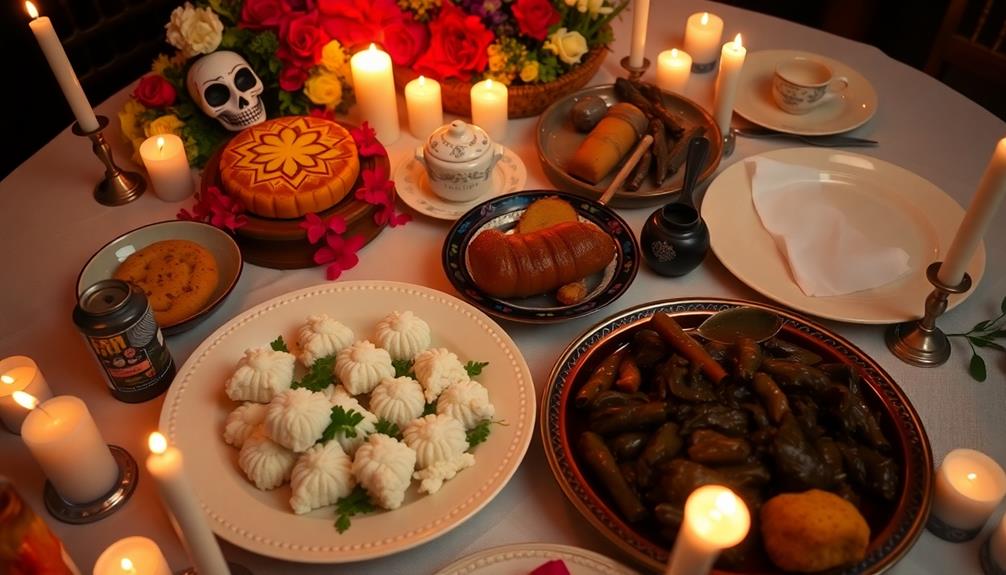Food plays a crucial role in how different cultures navigate grief and mourning. You might notice that Jewish, Chinese, and Mexican traditions use specific foods to symbolize life, connection, and remembrance. For instance, Jewish customs include eggs and lentils, while Chinese rituals feature lavish meals like pork for the departed. Comfort foods provide solace, from casseroles in the U.S. to pasta in Italy. These shared meals not only honor the deceased but also strengthen bonds among mourners. By embracing these culinary practices, you can better understand the deeper emotional connections food creates during times of loss.
Key Takeaways
- Various cultures prepare specific foods to honor the deceased, symbolizing life cycles and communal support during mourning.
- Comfort foods play a crucial role in grief, providing familiar tastes and emotional solace to those in mourning.
- Shared meals foster community connection, allowing mourners to support each other and celebrate the life of the deceased together.
- Rituals involving food, such as Jewish shiva or Mexican Dia de los Muertos, emphasize remembrance and respect for the departed.
- Cooking and sharing meals can serve as a therapeutic outlet, helping individuals process grief and preserve memories of their loved ones.
The Symbolism of Mourning Foods
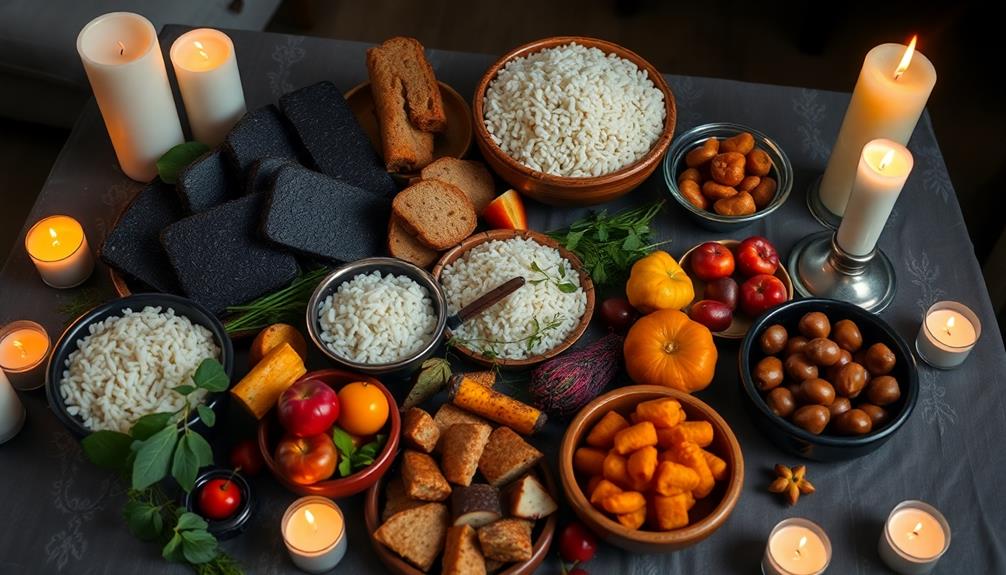
Throughout history, different cultures have used food as a powerful symbol during mourning processes. Mourning foods carry deep symbolism, reflecting emotions tied to grief while honoring the memory of the deceased.
For instance, in Jewish traditions, eggs and lentils serve as reminders of life's cycle and rebirth, offering hope amidst sorrow. Similarly, Chinese customs involve lavish meals, like pork and barbecue duck, intended to provide sustenance for the departed's journey in the afterlife.
In Brazil, dishes like Caldeirada can be associated with family gatherings during times of mourning, where shared meals foster connection and remembrance among loved ones. In contrast, Japanese mourning practices focus on a vegetarian diet for 49 days, emphasizing simplicity and the somber nature of grief. This unadorned fare symbolizes respect and solemnity, allowing the bereaved to reflect on their loss.
Hindu traditions also lean towards vegetarian dishes and fruit offerings, promoting purity and respect for the deceased during mourning.
These diverse cultures illustrate how mourning foods embody traditions that help navigate grief. By incorporating specific foods, families engage in rituals that serve not just as nourishment, but as a way to connect with their loved ones and the cycle of life.
Through these customs, food becomes a heartfelt expression of love and remembrance during times of loss.
Comfort Foods Across Cultures

When you think about comfort foods during times of grief, it's clear that different cultures have their own traditional dishes that hold deep meaning.
In Lebanese culture, foods like Kawarma (Preserved Meat) are often cherished for their rich flavors and communal aspects, symbolizing togetherness during difficult times.
These meals often symbolize continuity, community, and shared experiences, offering nourishment not just for the body but for the soul.
Exploring these comforting foods can reveal how they foster connections and support among those mourning.
Traditional Comfort Dishes
What role do traditional comfort dishes play in the grieving process? These meals provide nourishment and create a sense of community support for grieving families. They often evoke memories and foster connections among those mourning, helping to ease the emotional burden. Each culture has its unique comfort foods that resonate during these difficult times.
Here's a look at some traditional comfort dishes across cultures:
| Culture | Traditional Comfort Foods | Purpose of Foods |
|---|---|---|
| United States | Casseroles, lasagnas, fried chicken | Nourishment & familiarity |
| Jewish | Bagels, cookies, kugel | Community support & comfort |
| Mexican | Mole, tamales | Honor favorite foods & nourishment |
In the U.S., comfort foods like potato salad and pies are common at funerals, offering familiarity. Jewish customs emphasize easy-to-share foods during shiva, reinforcing community bonds. Meanwhile, Italian families gather over pasta dishes, while Mexicans prepare rich meals to honor the deceased. These traditional foods serve as an essential part of the mourning process, providing both emotional and physical sustenance.
Symbolic Food Meanings
Exploring the symbolic meanings behind comfort foods reveals how deeply intertwined culinary traditions are with cultural mourning practices.
In Jewish mourning traditions, meals of consolation often feature eggs and lentils, symbolizing life's cycle and continuity. This connection to the cycle of existence provides comfort during times of grief.
In Southern U.S. funerals, comfort foods like fried chicken and potato salad nurture mourners, offering a sense of familiarity and warmth amidst loss.
Similarly, Mexican mourning practices showcase dishes such as tamales, prepared to honor the deceased and provide solace to grieving families, reflecting the rich history of using corn in traditional dishes.
In Italy, customs emphasize serving pasta and bread after funeral services, reflecting communal support and the comforting role of food in mourning.
Similarly, Korean jesa rituals involve a table of food offerings, symbolizing respect for the deceased and inviting family to partake in the remembrance.
These diverse traditions illustrate how food serves not only as nourishment but also as a profound expression of grief, love, and cultural identity.
Through these symbolic meanings, comfort foods become an essential part of the mourning process, helping individuals navigate their shared sorrow across various cultures.
Shared Meals Significance
Sharing meals during times of grief creates a powerful bond among those mourning. Comfort foods serve as more than just nourishment; they symbolize support and community. Different cultures have unique traditions surrounding shared meals during grieving, emphasizing connection and remembrance.
| Culture | Shared Meal Traditions |
|---|---|
| United States | Casseroles and lasagnas are often brought to bereaved families. |
| Italy | Communal meals after funerals feature comforting pasta dishes. |
| Ghana | Large feasts celebrate the life of the deceased with family and community. |
| Mexico | Dia de los Muertos includes preparing favorite foods of the departed. |
| Jewish | During shiva, easy-to-share foods like bagels and cookies foster connection. |
These shared meals not only provide physical sustenance but also create emotional support networks among those grieving. They help people come together, honor the deceased, and navigate the mourning process collectively. By participating in these traditions, you actively contribute to a sense of community and healing, transforming grief into a shared experience enriched by love and connection.
Social Connections Through Shared Meals
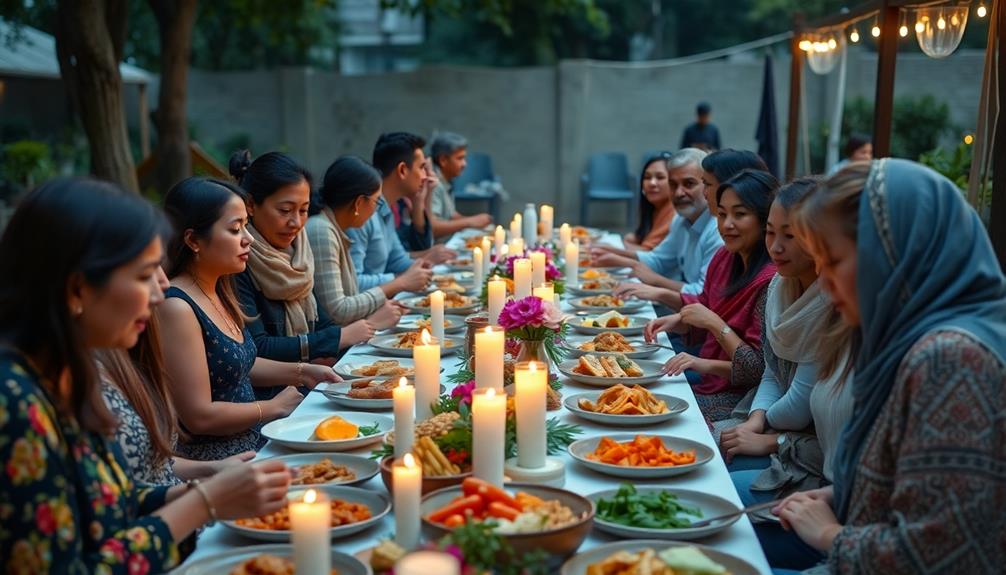
Food plays an essential role in forging social connections during times of grief. When you share a meal with others, it creates a space for support and collective mourning. This connection can be particularly powerful, as it allows you to process your emotions with those who understand your pain.
Across cultures, shared meals offer a comforting means of honoring the deceased while fostering community bonds.
Consider how different traditions embody this practice:
- In the U.S., friends often bring casseroles to the bereaved, providing nourishment and emotional support.
- Ghanaian funerals feature large communal feasts, celebrating the life of the deceased and strengthening social ties.
- Italian mourning customs encourage families to gather for shared meals, emphasizing collective remembrance.
- In Oaxaca, Mexico, sharing food helps community members connect and process their grief together.
- Jewish shiva practices involve meals brought to the mourners, creating an environment for solace and companionship.
These shared experiences not only help alleviate the weight of grief but also reinforce the importance of community during difficult times.
The act of coming together over food serves as a reminder that you're not alone in your mourning journey.
Food Rituals in Funerals
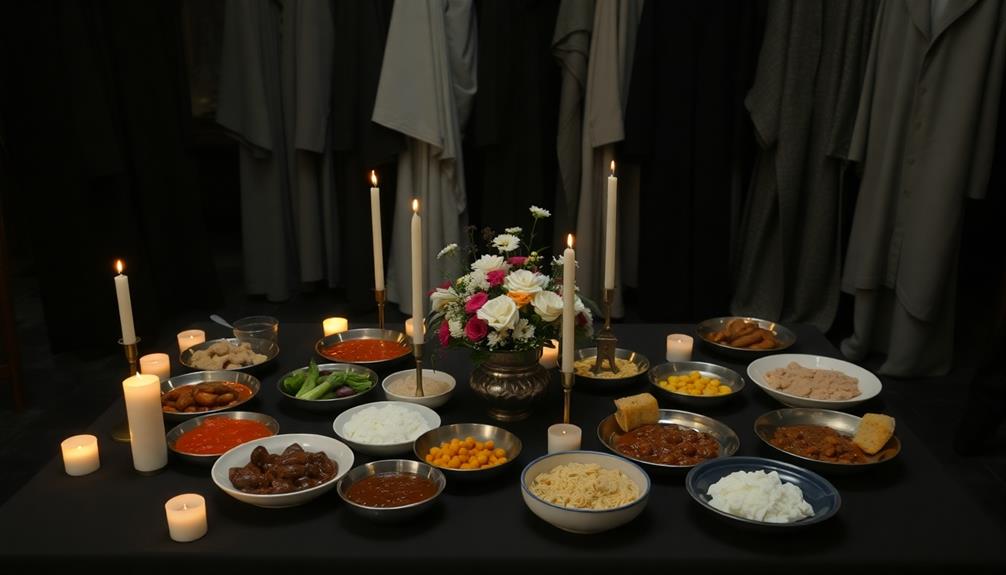
When you think about food rituals in funerals, it becomes clear how deeply culture influences these practices.
Different communities prepare specific offerings that not only honor the deceased but also foster a sense of togetherness among mourners.
Cultural Food Offerings
Across cultures, food plays an essential role in mourning rituals, serving as a bridge between the living and the deceased.
These cultural food offerings not only provide sustenance but also embody deep meanings in various mourning traditions. They reflect the cycle of life and serve to honor ancestors while fostering community support during difficult times.
Some key elements of these rituals include:
- Chinese offerings: Lavish meals like pork and barbecue duck are prepared to nourish the deceased in the afterlife.
- Jewish shiva meals: Eggs and lentils symbolize the cycle of life and offer comfort to the bereaved.
- Korean jesa: A table filled with rice, fish, and fruits invites ancestral spirits to partake in the feast.
- Hindu post-cremation meals: Vegetarian dishes and fruits honor the deceased's life and signify the soul's release.
- Italian post-funeral gatherings: Comfort foods like pasta and bread encourage community support and remembrance.
Through these rituals, food transcends mere nourishment, fostering connections and shared experiences that resonate across generations.
Communal Eating Practices
Gatherings after a funeral often center around shared meals, creating a space for mourners to come together in remembrance and support. In many cultures, communal eating practices play an essential role in the mourning process, honoring the deceased while reinforcing family bonds.
For instance, Italians often gather for pasta meals, reflecting on the life of the departed. Similarly, during Korean jesa rituals, families arrange meticulous food offerings and share a meal, emphasizing respect for ancestors and unity.
In Jewish traditions, friends and community members bring comfort foods like bagels and cookies to families in shiva, fostering a supportive environment where shared grief and memories flow freely.
Ghanaian funerals focus on large feasts that celebrate the life of the deceased, highlighting how communal eating strengthens social ties among attendees.
Chinese mourning customs also invite family and friends to share meals after the funeral, using specific dishes to symbolize honor and the continuation of legacy.
These cultural customs illustrate how communal eating creates a nurturing space for mourning, allowing individuals to connect, heal, and find solace in shared experiences.
Asian Cultural Practices in Mourning

Asian cultural practices in mourning are rich with symbolism and community engagement, emphasizing the significance of food in honoring the deceased. In these rituals, food becomes an essential part of the grieving process, fostering connection among mourners and serving as a tribute to those who've passed.
Here are some key elements of Asian mourning practices involving food:
- Koden Tradition (Japan): Monetary gifts help cover food preparation costs for funerals, highlighting shared meals.
- Jesa Rituals (Korea): A table filled with offerings like rice and fruits honors the deceased and supports their spiritual journey.
- Hindu Funerals: Post-cremation, vegetarian meals symbolize purity, with communal meals continuing for several days to aid the grieving family.
- Sikh and Muslim Funerals: Emphasis on communal meals fosters solidarity among mourners, honoring the deceased through shared food.
- Chinese Mourning Practices: Lavish meals, including pork and barbecue duck, are served to friends and family, along with food offerings, reflecting respect and beliefs in the afterlife.
Through these cultural practices, food plays a significant role in the mourning process, connecting individuals with their heritage and each other.
European Mourning Food Traditions

Food traditions in mourning are just as significant in Europe as they're in Asia, with each culture incorporating unique dishes to honor the deceased.
In Italy, you'll notice comforting meals like pasta and bread served during mourning gatherings, emphasizing the importance of communal eating to foster connections among mourners.
Greek memorial traditions often feature koliva, a special dish made from boiled wheat that symbolizes death and rebirth. Sharing this dish among mourners enhances the remembrance of the departed.
In Ireland, wakes bring people together with traditional foods like soda bread and cheese, creating a supportive atmosphere to celebrate the deceased's life.
Meanwhile, in the UK, funeral teas offer light meals designed to facilitate conversation and provide comfort during times of grief.
Additionally, South African funerals often showcase large communal feasts that highlight togetherness and the celebration of life, reinforcing community bonds through shared foods.
These European mourning traditions not only provide nourishment but also play an essential role in offering comfort and support, helping the grieving process through the act of sharing meals and memories.
African and Middle Eastern Customs
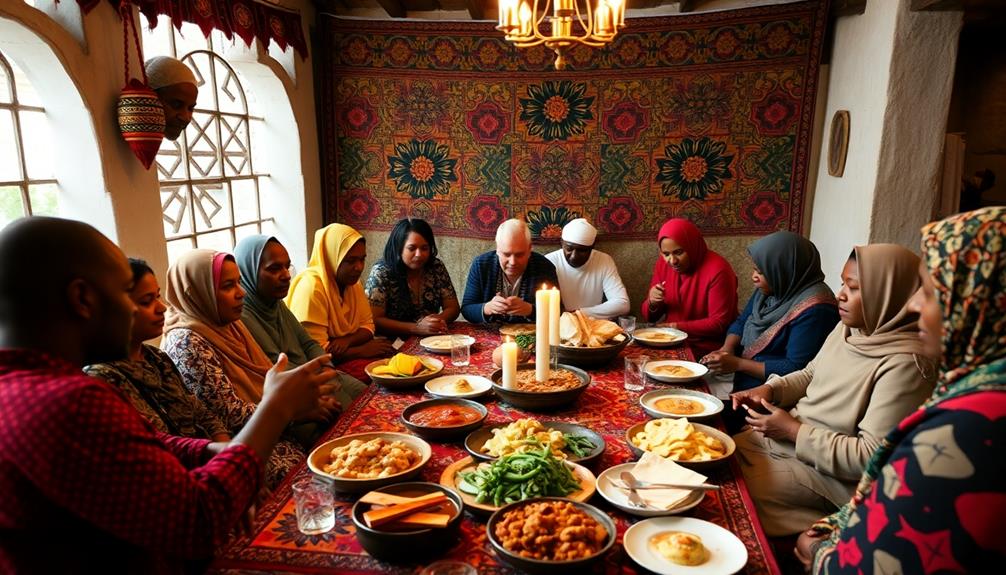
In many African and Middle Eastern cultures, food plays a pivotal role in mourning customs, serving as an essential link between the living and the deceased. These cultural customs often emphasize communal meals, allowing friends and family to come together in support during the grieving process.
You'll find that traditional dishes are prepared with care, reflecting the values of abundance and remembrance.
Here are some common practices you might encounter:
- In Egypt, the dish called fatta, made from rice and meat, symbolizes abundance and renewal for the deceased's journey into the afterlife.
- South African families often engage in the ukubuyisa tradition, cooking meals for the spirit of the deceased, reinforcing their connection.
- Middle Eastern cultures emphasize shared meals featuring rice and lamb after funerals, fostering solidarity among mourners.
- During Jewish shiva, comforting foods like kugel and challah are brought to the bereaved family, showcasing community care.
- In Muslim traditions, large communal meals honor the deceased, highlighting the collective nature of grief.
Through these familiar practices, food serves as a crucial way to navigate loss and celebrate memories.
Remembrance Through Food Offerings
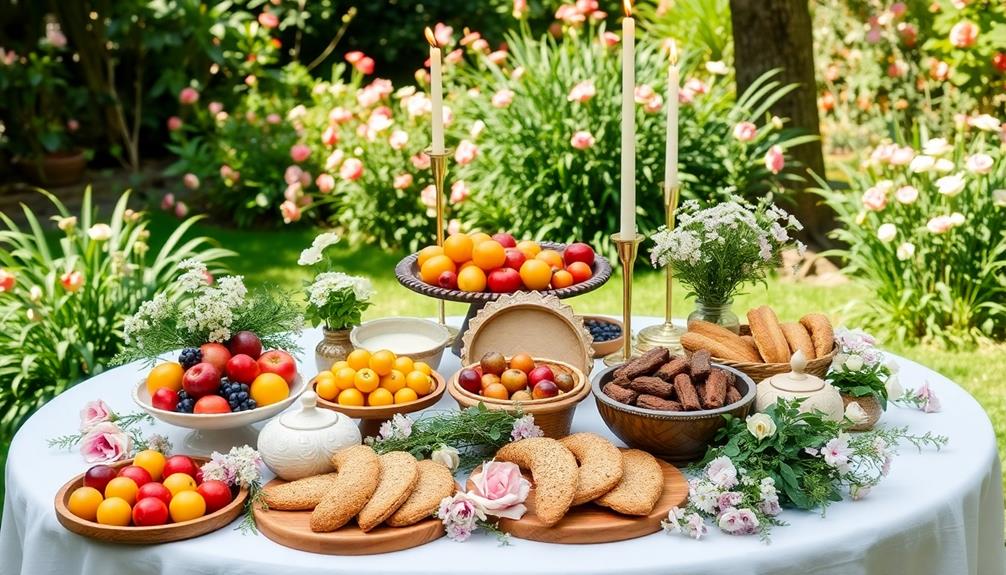
Cultural practices around grief often incorporate food offerings as a profound way to honor and remember lost loved ones. In many cultures, these food offerings serve as a bridge between the living and the deceased, nourishing both body and spirit.
For instance, during Día de los Muertos in Mexico, families prepare the favorite foods of their departed, like tamales and pan de muerto, creating a vibrant altar that celebrates remembrance.
In Chinese traditions, mourners present dishes like pork and barbecue duck, symbolizing sustenance for ancestors in the afterlife. Similarly, Jewish customs during shiva feature meals with symbolic foods such as eggs and lentils, representing life's continuity and providing comfort to bereaved family members.
Korean jesa rituals involve beautifully arranged food offerings, including rice and fruits, inviting the spirit of the deceased to partake in the family meal.
Italian mourning traditions often feature communal meals centered around comfort foods like pasta, fostering togetherness while celebrating the life of the departed.
Through these shared meals, cultural traditions emphasize the importance of food offerings in the mourning rituals, allowing families to find solace and connection amid their grief.
Psychological Aspects of Mourning Foods
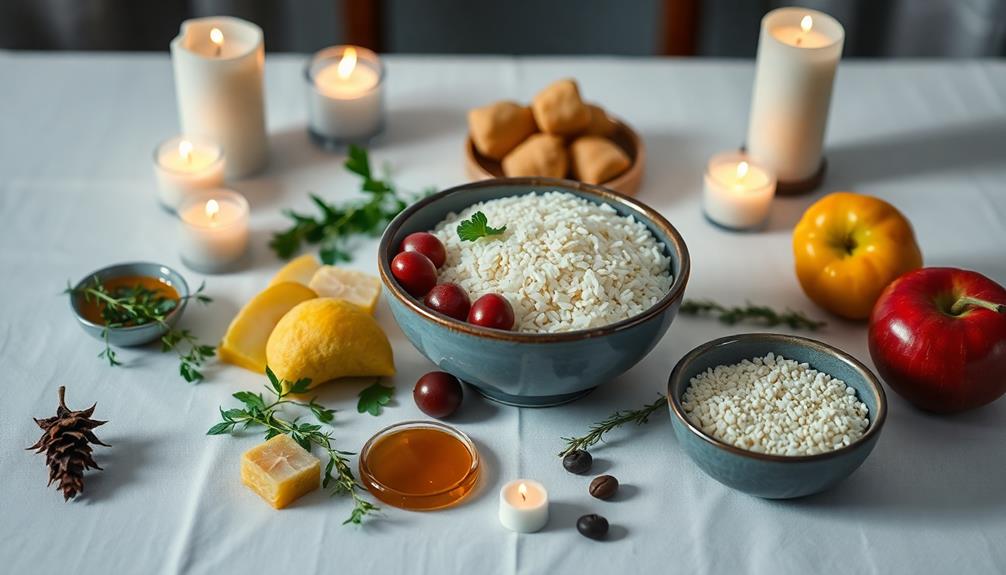
While grieving, you may find that engaging in the preparation of familiar meals can be a comforting and therapeutic way to navigate your emotions. Cooking can help you express your feelings and alleviate stress during this challenging time.
Comfort foods often evoke cherished memories of the deceased, offering a sense of connection and continuity.
Consider these psychological aspects of mourning foods:
- Emotional expression: Cooking allows you to channel your grief into a creative outlet.
- Culinary traditions: Engaging in cultural food practices can honor the memory of your loved one.
- Collective support: Sharing meals with others fosters community and connections among mourners.
- Symbolic gestures: Specific dishes can serve as tributes, representing your emotional journey through grief.
- Appetite changes: Grief can alter your food preferences, making comfort foods even more significant.
Together, these elements underscore how food plays an essential role in the mourning process, helping you heal and remember.
Embrace cooking as a therapeutic activity that brings solace and encourages reflection amidst your loss.
Frequently Asked Questions
How Do Different Cultures Deal With the Grieving Process?
Different cultures handle grief uniquely. You might find structured mourning periods in Hindu and Tibetan practices, while the Lakota tribe emphasizes communal connections. In contrast, Egyptian customs allow extended mourning, reflecting diverse approaches to loss and remembrance.
What Is the Role of Food in Death and Grief?
Food plays an essential role in death and grief. You gather with loved ones, sharing meals that evoke memories and emotions. It comforts you, strengthens connections, and provides a sense of normalcy during overwhelming times.
What Food Symbolizes Grief?
You might think any food could symbolize grief, but specific dishes like lentils or casseroles truly resonate. They represent support, community, and the cycle of life, offering comfort while honoring memories of those we've lost.
Why Do People Bring Food to Grieving Families?
You bring food to grieving families because it shows your support and compassion. It eases their burden of cooking, fosters connection, and creates opportunities for heartfelt interactions, helping everyone heal during a difficult time together.
Conclusion
In the tapestry of grief, food weaves threads of comfort and connection, binding us to those we've lost. Each bite of a traditional dish sings a lullaby of memories, while shared meals create a sanctuary for healing. Whether it's a fragrant curry or a warm loaf of bread, these culinary rituals remind us that love transcends even the deepest sorrow. So, as you gather around the table, let the flavors of remembrance nourish your spirit and celebrate life.
